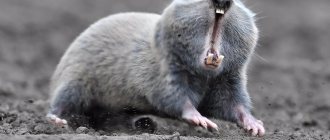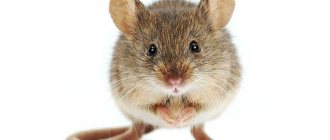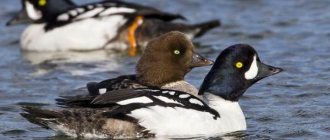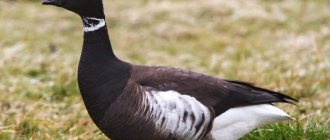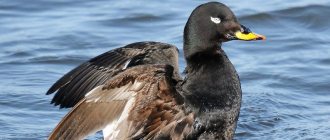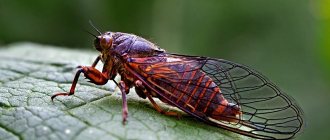- Wild animals
- >>
- Mammals
The marten is a medium-sized predatory mammal with a beautiful body and a large tail.
Representatives of the mustelid family are excellent hunters, have developed paw motor skills, as well as sharp fangs and claws that can cause lacerations to humans. Adults engage in gymnastics, which allows them to live up to 20 years, and the cubs constantly play, making cooing sounds.
Description
The most striking and widespread member of the marten genus is the pine marten . Its strong body has an oblong shape with dense sides, the average length is 40-58 cm. The fur is thick and soft, dark brown in color, a light chestnut shade is less common. The fur on the sides is lighter than on the back and belly. The tail is long and dark in color. Its length is 18-28 cm. The height of the marten at the withers is 15-18 cm.
The paws are thick and short, each with 5 separate toes with strong, sharp claws curved down. The neck is shortened, but very mobile. On the chest there is a characteristic spot of light yellow color (in some individuals it can be bright orange). Thanks to this, the marten was nicknamed the yellowbird. The head is small with a black narrow nose. The eyes are dark and round, set close to the nose. At night they glow with a reddish tint.
The rounded ears stick out vertically. Along their inner edges, like a rim, there is a light stripe. The mouth is narrow, but quite deep with small teeth in the shape of a triangle. There are large fangs on the sides of the upper and lower jaws. On both sides near the nose there are thin, stiff mustaches. The average weight of a marten is 1.3-2.5 kg.
Where does the marten live?
Photo: Pine marten
The pine marten can be found in Europe, northern Asia and the Caucasus. In the territory it lives on tall trees of the Urals and Western Siberia. Sometimes it can be found in Moscow city parks: Tsaritsyno and Vorobyovy Gory. Gradually, the sable unscrupulously pushed it out of the range of the Ob River; previously it was found there in sufficient quantities.
Sable occupied a wider territory: Siberia, northeast China, Korea, northern Japan, Mongolia, and partly the Far East. Unlike the pine marten, it prefers to run on the ground rather than climb trees, and loves to live in coniferous rather than deciduous forests. These sedentary animals rarely change their location, only in severe cases: fires, lack of food or oversaturation with predators.
Kidas, as the heir of the pine marten and sable, lives in the places where these predatory individuals intersect. According to eyewitnesses, it is most often found in the Pechora River basin, in the Trans-Urals, Cis-Urals and northern Urals. Like the sable, it prefers a terrestrial existence.
The pine marten, unlike its relatives, loves a warmer climate and lives further south. The habitat covers almost all of Eurasia and stretches from the Pyrenees to the Mongolian steppe and the Himalayan ranges. Loves steppe terrain with numerous bushes. Some populations feel good at an altitude of 4000 meters, which is why they got their name.
Kharza prefers a hot climate and lives even further south than the pine marten. There is quite a lot of it on the Hindustan Peninsula, Chinese plains and islands. It is found in Malaysia, as well as the Amur region, Primorsky and Khabarovsk territories. Some residents of the Amur region sometimes also encounter harza, but less often.
Peculiarities
The marten is an agile and agile predator. Despite its short legs, it is capable of moving at high speed with large leaps (up to 4 m in length), leaving traces of its hind legs on the marks of its forelimbs.
With the same ease, the animal moves to heights, digging its claws into the bark of a tree. In this case, the feet tend to rotate to the sides by 180 degrees. The marten can half hide its claws inside and release them at the time of hunting or danger.
The tail not only decorates the animal, but is also an important tool. It helps the body maintain balance in an upright position, move boldly along thin branches and jump from one tree to another. Thanks to its tail, the marten can fall softly from great heights without causing harm to itself.
On the stomach, close to the tail, there is a special gland called the anal gland. It secretes a special liquid - a secret. Females have 2 mammary glands. The soles of the marten's paws are bare in summer, and in late autumn they begin to grow hair, thanks to which the animal easily moves through the snow without falling into snowdrifts. The coat also varies by season - in winter the fur is long and silky, with an undercoat of light colors. And in the summer months it thins out, becomes shorter and coarser.
The marten has a keen sense of smell, excellent hearing, and moves freely in the dark. She has well-developed motor skills of her limbs. This animal can swim, but tries to avoid water, preferring to be at heights or move on land. Males are more active and always larger than females.
These predators are capable of making a variety of sounds - a menacing growl or abrupt bark, like dogs, or meowing and howling, like cats. The marten in the photo looks like a cute, defenseless creature, but this is a deceptive impression - it is an insidious predator and knows how to stand up for itself. Kills prey with a deep bite to the back of the head.
Interesting Facts
The marten is a small and agile predator. There is no crack that a flexible rogue cannot fit through. Some species are considered elusive and virtually nothing is known about their lifestyle. Sable, mountain, forest and Ussuri species are considered well studied.
Interesting Facts:
- At night, in the light of the moon or a dim lantern, the marten's eyes glow red. Because of this, in some countries it is called the “forest devil.”
- Martens are the only members of the family that can retract their claws halfway.
- Most species are omnivores.
- Representatives of the family make winter supplies and hide food in empty hollows and rock crevices.
- The marten has difficulty adapting to captivity, so they try not to keep them locked up even in zoos and nurseries.
- Marten fur is considered one of the most expensive in the world.
- Marten is the mascot of the Salavat Yulaev hockey club.
- Little sneaks often settle near human habitation. But such a neighborhood does not bring joy to people. Nimble predators destroy poultry houses, chew wires, eat rubber and plastic parts in mechanisms, and also pull out soft and warm materials from the casing for their nests. Motorists and home owners near forested areas can insure themselves against damage caused by martens.
- In ancient times, marten skin had a fixed monetary value. One unit (skin) was called kuna.
- Martens mark their areas using anal glands. The musky secretion has an unpleasant odor with floral notes.
Kinds
The marten genus contains several species and subspecies, each of which has its own characteristics. The most common types are the following.
- Stone marten (white marten). Her fur is short and dark gray. There is a white spot on the neck that stretches to the front legs and bifurcates, and there are individuals without a bib at all, just gray. It is similar in size to the wallflower, but heavier in weight. Her nose is light, and the skin between her ears is paler than on her body. The feet are not covered with hair.
She is the bravest among her brothers, makes nests close to people's houses, and hunts domestic animals. He does not like to jump into trees; for hunting he chooses open expanses of plains with bushes and forest plantations.
It is capable of living in the mountains, at an altitude of more than 4 thousand m, as well as in rocky areas with sparse foliage, which is why it received this name. The fur of this marten is less valuable than that of other species.
- Kharza or Ussuri marten. One of the largest representatives of the genus. It reaches a length of up to 80-90 cm and weighs more than 5.5 kg. The color is unusual - the head, end of the back, hind limbs and tail are dark or black, and the body is of variegated shades.
The body palette is very diverse: bright red, yellow, pale sand or with multi-colored stripes. The lower jaw is white. The fur is short, with a thick undercoat. This marten can remain in one place on rare occasions; it does not experience any inconvenience when migrating over large areas.
- American marten. The body structure is typical of martens, but smaller in size than their counterparts. The male’s body is 35-45 cm long and weighs no more than 1.5-1.7 kg. Females grow up to 40 cm and weigh about 1 kg. The color of the skin is brown or light chestnut, and the tail, paws and nose are dark in color.
Some individuals have 2 dark stripes near the eyes. The fur is long and soft, the tail is fluffy. Martens of this species are very cautious and timid, emerging from cover only under the cover of darkness.
- Nilgiri Kharza. A rare representative of its kind. The dimensions of this animal exceed average, body length 60-70 cm, weight more than 2.5 kg. It cannot be confused with other martens due to its unique coloring. The whole body is dark brown, and on the chest there is a bright orange spot, which bifurcates near the front legs. The nose is pink, the frontal bone on the skull is noticeably arched.
- Ilka or fishing marten. It can compete in size with the harza, growing up to 90 cm in length and weighing more than 5.5 kg. The fur is long and thick, but tough. From a distance, this marten appears black, only up close it is possible to see that the head and neck are lighter than the body, and the fur is brown. Some animals have a white spot on the chest with a grayish tint. The paws are thicker than those of other martens, which allows them to confidently move through deep snow.
There is also an animal called kidas (or kidus) - this is a natural mixture of sable and marten. He adopted his appearance and habits from both parents. Kidas males are sterile, so they cannot reproduce.
general characteristics
The marten has a flexible and slightly elongated body, which allows the animal to crawl into any cracks. The size of adult individuals, depending on the species, is from 40 to 80 cm in length, the tail is from 15 to 31 cm. Weight is from 0.52 to 6 kg. The smallest representatives of Mustelidae are American martens; the weight of mature individuals does not exceed 1.5 kg. The largest are yellow-breasted martens, whose body weight varies from 3 to 6 kg. Sexual dimorphism is weakly expressed; females can be distinguished from males only by size, since the external genitalia are hidden by fur.
Members of the family have relatively short limbs.
The paws have five toes with well-developed and slightly curved claws. This is the only representative of Mustelidae whose claws are partially retracted when walking. Thanks to this, the animals calmly climb trees, and while moving on the ground, their claws do not cling to uneven surfaces.
The back of the head is rounded, the muzzle is neat and slightly elongated. The nose is small and well developed. The ears are small in size, round or softly pointed. Chewing teeth and canines are well developed.
All mustelids have soft, dense fur.
Depending on the species, the color can be brown, dark brown, bright yellow, sandy, grayish or black. The lower part of the body is usually a lighter shade. Some varieties have light spots on the body, as well as a black or light mask on the face.
Elena
Ask a Question
Question to the expert
How long do martens live?
In the natural environment, life expectancy depends on conditions. On average, martens live from 6 to 15 years. In a zoo they can live up to 18. Among mustelids, the sable is considered a long-liver; on average, individuals can live from 12 to 18 years, in nurseries up to 22 years.
Lifestyle
The marten is a solitary animal . It does not create a family; males and females meet only to conceive offspring; the rest of the time they live and hunt separately. The exception is the Ussuri martens, which are capable of chasing game in a flock of 4-5 members.
Each individual has its own territory with an area of 5-30 km, and the boundaries are marked with urine and secretions from the anal gland. The dwellings of males are always larger than those of females and can overlap with the female domains.
The predator can live on its lands for years, but does not have a permanent home. For rest, he selects 5-6 places, which he also marks and constantly changes. Any shelter is suitable as a shelter, preferably at a height:
- hollow or crevice higher than 2 m from the ground;
- squirrel hole;
- bird's nests;
- deep gorges between stones.
They are usually friendly towards each other. Males can fight either for a female during the mating season or for territory; in other cases, aggression does not manifest itself. Martens are nocturnal - they hunt and play in the dark, and sleep during the day. Only the Nilgiri harza is active during the daytime, while the ilka forages for food at any time of the day.
They can leave their area if they are chasing squirrels, while trying not to go down to the ground unnecessarily, but to pursue prey by jumping on branches. These animals are cautious and avoid people.
Only the stone marten wanders without fear near human habitation and raids pens with domestic animals. The marten constantly moves in search of food, and only in winter it lies in shelter for a while and feeds on previously prepared food.
Pine marten behavior
The pine marten lives up to its name, since none of its relatives is found so often in forests and trees.
This animal climbs and jumps well, capable of covering a distance of 4 meters in a jump. When a pine marten crawls, it turns its feet at an angle of about 180°. Pine martens choose shelters in hollows, or they occupy abandoned structures of squirrels and nests of birds of prey. In such shelters, animals rest during the day, and at dusk and nightfall they go in search of their prey.
Pine martens have very pronounced territorial behavior; they mark their area of residence with the help of a secretion secreted by the anal gland. The areas of males and females of this species may overlap, but animals try to drive away individuals of their own sex from their territory. The size of the site varies quite a lot, but usually males occupy larger areas than females. In addition, summer territories always exceed winter ones in size.
Habitat
The distribution area is very wide. The marten lives in almost all forested areas and mountain ranges with dense vegetation, where there is a temperate or cold climate. Favorite environments are wide deciduous, coniferous or mixed areas with perennial trees and abandoned edges. Animals are distributed according to their characteristics:
- the pine marten prefers pine, coniferous and mixed forests of Europe and the northern part of Asia, has chosen the massifs from Western Siberia to the Baltic Islands, it also lives in the Caucasus and the south of the Mediterranean;
- the stone marten is found on rocky terrain throughout almost all of Eurasia, from the Himalayas to the Iberian Peninsula, and it was also artificially populated in the state of Viscontin (USA);
- Kharza inhabits the Ussuri and Amur regions of Russia, the eastern and southern parts of China, the Himalayan mountains and eastern Asia;
- The American marten lives in North America; it has inhabited forests from New Mexico to northern Alaska;
- the Nilgiri marten lives in the highlands of the Nilgiria, in the mountain ranges of the Western Ghats - only this species can be found in southern India;
- Ilka lives in the east, west and center of North America, including the mountainous regions of California to the borders of West Virginia.
The Japanese sable is a rare species of the genus of martens, and it lives in small numbers on the Japanese islands (Kyushu, Shikoku, Honshu), as well as in North and South Korea.
Kharza
This large predator bears little resemblance to other species of martens. The coloring is bright: a black head with a white chin and reddish cheeks, a bright yellow chest, golden fur on the back, dark brown paws and tail. The coat is short and shiny. The size of the animal ranges from 55 to 80 centimeters, and its weight sometimes reaches 6 kilograms.
Kharza settles in deep forests, away from people. Only females who feed their babies live sedentary. The remaining individuals move freely in search of prey, resting in hollows, crevices, and windbreaks. In addition to small rodents, the harza attacks young deer, wild boars, roe deer and moose. Favorite prey is musk deer. During hunting, animals can unite in groups, which is unusual for other representatives of the species. Another feature of them is their love for honey.
Where do martens live? Kharza inhabits the countries of Asia and the East: China, Korea, India, Pakistan, Afghanistan, Turkey, Nepal, Iran, Georgia, etc. Animals are found in the foothills of the Himalayas, in the taiga and humid tropics, on the ocean coast and in swampy areas. On the territory of Russia, the animals are found in Primorye and the Amur region; they were also brought to Crimea, Adygea and Dagestan.
Nutrition
The marten is an undemanding predator in food, but its main diet is animal food. It hunts all small rodents, birds, large insects and even hedgehogs that inhabit its territory.
If there is a body of water nearby, frogs, snails, larvae, fish and their eggs are added to the menu. This animal steals laid eggs and eats honeycombs from wild apiaries. Favorite dishes: squirrel, vole, shrew, black grouse, capercaillie and others.
The marten loves fresh food, but does not disdain carrion. In the summer months, omnivores eat wild berries, rose hips, wild apples and pears, and nuts. Rowan occupies a special place in the diet. It is frost-resistant and its composition has anthelmintic properties. Predators eat it all year round, picking berries while sitting on the branches.
What does it eat?
The marten is an omnivore. The main part of the diet consists of rodents, reptiles, insects, and small birds. The animal can also destroy bird nests located on tree branches and on the ground. If there is a body of water near the hunting grounds, snails, frogs, and fish fry are eaten.
During periods when there is very little animal food, the predator switches to a plant-based diet, eating nuts, wild berries, seeds, and the fruits of wild apple and pear trees.
The marten is the worst enemy of squirrels: it is capable of chasing a rodent that comes into view for a long time, overtaking it in a tree or in a hollow. Often, after a successful hunt, martens use squirrel nests as temporary resting places.
The predator can eat carrion, although it does so reluctantly and when absolutely necessary.
Reproduction
Martens become sexually mature at 2 years, but usually produce their first brood in the 3rd year. In February, mating games occur, but they are called “false rut” because conception does not occur. Individuals mate in June-July, at which time the females begin estrus, which lasts 2-4 days. There are several of them over the summer, the break between them is 1-2 weeks. One male fertilizes 3-5 females.
The egg does not immediately attach to the uterus; first there is a long latent stage, and the embryo itself develops in only 30-40 days. Before giving birth, the mother looks for a place for her offspring, choosing secluded spacious nests or an old hollow. Pregnancy lasts 8.5-9 months, after which blind and deaf cubs appear in March-April. The marten brings 2-4 babies at a time, in rare cases 5-7 animals are born.
The weight of a newborn is 30-40 g, the length of the body is 100-110 mm. Babies are covered with thin and short fur. They have no teeth, for the first 40-45 days they feed on their mother’s milk and actively gain weight. The mother leaves the nest to hunt, and in case of danger, drags the brood to another place. The first thing babies develop is hearing (after 20-25 days), and after 5-7 days their eyes open.
At 7-8 weeks, the first teeth erupt, and the cubs switch to solid food and begin to emerge from shelter. At 2.5 months, babies are actively moving, their mother introduces them to the world around them and teaches them to hunt. At 16 weeks, puppies know and can do everything, but until September they live near their mother. In the fall, the family breaks up, and everyone leaves to look for their place.
Nilgiri Kharza
This exotic marten is colored in shades of dark brown, while the neck and chest are a striking orange color. The size of an adult animal can range from 55 to 70 centimeters. The weight is significantly less than that of a regular harza - from two to 2.5 kilograms.
Where does the marten live and what does it eat? The Nilgiri harza is the only and endangered member of the mustelid family in South India. This species is still poorly studied. The lifestyle is presumably diurnal. Individuals are found in tropical forests at higher elevations. Animals avoid people. Nests are built in trees, close to water. But the animals hunt on the ground. They feed on small birds, rodents, lizards and monitor lizards, cicadas, and Asian deer.
Lifespan
In captivity, the marten takes root reluctantly and in different ways - either it becomes domesticated, or it shows aggression. If the outcome is favorable, she can live up to 15 years or more. In the natural environment, a valuable predator can live 11-13 years, but in reality it rarely reaches that age. The animal is vulnerable to parasites and infections that lead to its death.
Also in the wild, other species of forest inhabitants see the marten as both a competitor and a possible meal. Its most active enemies are fox, lynx and wolf, as well as agile birds - eagle owl, golden eagle and hawk.
But the main culprit in the extermination of animals is man. Marten fur has always been expensive. Even in widespread species such as stone marten or yellowjacket, it has never been cheap.
Natural enemies
The main enemies of the marten in nature are larger predators: foxes, wolves, lynxes, wolverines. In most cases, the nimble and fast animal manages to escape from its pursuers. Birds of prey pose a much greater danger to him: hawks, golden eagles and eagle owls.
The kharza, the largest and strongest of all martens, suffers least from attacks from predators.
WOLF
Marten hunting
The marten is a valuable game animal. The hunting season begins in November and lasts until March, while the animal’s fur is thick and fluffy. In the spring, the skin becomes dull and molts, and then the predator is destroyed only as a pest (usually the stone marten, which annoys farmers). Martens are most often caught with traps and self-catchers.
Nilgiri harza and Japanese sable are protected by law. Hunting marten of any of these unique members of the mustelid genus is prohibited. Hunting for other predators is permitted with a one-time license, the cost of which depends on the type of animal. When catching marten without this document, hunting is considered poaching and is prosecuted by law.
Listen to the voice of the marten
Martens have sharp teeth, thanks to which they easily cope with animal and plant food. The marten's diet consists of voles, squirrels, small birds and eggs.
The animals also eat insects, reptiles and even carrion. The marten kills its prey by biting it on the back of the head. Martens eat berries, nuts and honey from plant foods. In autumn, animals store food for the winter.
Stone marten.
Sable
This strong animal leads a terrestrial lifestyle, climbing trees only in case of danger. The color of sables is varied and very beautiful: from fawn, light brown to almost black. Agile animals settle in the taiga. Dwellings are made in hollows or under tree roots. They feed on plant foods, small rodents, large birds, fish, and attack hares, stoats, and musk deer.
Where do martens of this species live? Sables are the original inhabitants of the Russian taiga. They are found from the Urals to the Pacific Ocean. There are also Japanese sables that inhabit the islands of Tsushima, Shikoku, Kyushu and Honshu. In order to obtain beautiful fur, animals were also brought to the islands of Sado and Hokkaido. Japanese sable can be tan or dark in color with a characteristic light patch on the back of the head.
Martens are a large family that lives in Europe, Asia, and North America. Currently, they can be found in most deep forests of Russia. However, some species are endangered and require special protection.


